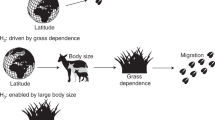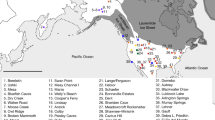Abstract
The Cenozoic history of land mammals is marked by brief periods of intercontinental dispersal, termed dispersal events1,2. One of these dispersal events includes the horse Equus, that evolved in North America, dispersed to the Old World in the Pliocene, and became a prominent member of Old World Pleistocene communities. Equus was derived from a species of the single-toed horse Pliohippus, known only from North America3. Timing for the Pliocene dispersal of Equus into Europe was questioned4 following resolution for the appearance of Equus into the Siwalik sequence of Pakistan5. It seems that there were at least three major dispersal events of large mammals during the Pliocene (at 1.9, 2.6 and 3.7 Myr). We now report new data that limit the time of Equus' dispersal and into Europe to the 2.6 Myr dispersal event.
This is a preview of subscription content, access via your institution
Access options
Subscribe to this journal
Receive 51 print issues and online access
$199.00 per year
only $3.90 per issue
Buy this article
- Purchase on Springer Link
- Instant access to full article PDF
Prices may be subject to local taxes which are calculated during checkout
Similar content being viewed by others
References
Simpson, G. G. Bull. Geol. Soc. Am. 58, 613–687 (1947).
Repenning, C. A. The Bering Land Bridge (ed. Hopkins, D. M.) 288–311 (1967).
Neville, C., Opdyke, N. D., Lindsay, E. H. & Johnson, N. M. Am. J. Sci. 279, 503–526 (1979).
Lindsay, E. H., Opdyke, N. D. & Johnson, N. M. Proc. Int. Conf. Field-workshop on the Stratigraphy of Loess and Alluvial Deposits IGCP Project 128 (in the press).
Opdyke, N. D. et al. Palaeogeog. Palaeoclimatol. Palaeoecol. 27, 1–34 (1979).
Cox, A. Science 163, 237–245 (1969).
LaBrecque, J. L., Kent, D. V. & Cande, S. C. Geology 5, 330–335 (1977).
Johnson, N. M., Opdyke, N. D. & Lindsay, E. H. Bull. Geol. Soc. Am. 86, 5–11 (1975).
Opdyke, N. D., Lindsay, E. H., Johnson, N. D. & Downs, T. J. Quat. Res. 7, 316–329 (1977).
Neville, C. et al. (in preparation).
Bjork, P. R. Trans. Am. phil. Society 607, 1–54 (1970).
Gustafson, E. P. Bull. 23, Mus. Nat. Hist. Univ. Oregon 1–62 (1978).
Bjork, P. R. Trans. Kansas Acad. Sci. 76, 24–38 (1974).
Repenning, C. A. J. Res. U.S. Geol. Survey 4, 305–315 (1976).
Tedford, R. H. & Gustafson, E. P. Nature 265, 621–623 (1977).
Hurzeler, J. Coll. International C.N.R.S. 163, 633–636 (1967).
Mein, P. Ann. Geol. Pays Hellenica, extra ser. 3, 1367–1372 (1979).
Tobien, H. Palaeogeogr. Palaeoclimat. Palaeoecol. 8, 77–93 (1970).
Heintz, E., Guerin, C., Martin, R. & Prat, F. Mem. B. R. G. M. 78(1), 169–182 (1974).
Bandet, Y., Donville, B. & Michaux, J. Bull. Soc. géol. Fr. 20, 245–251 (1978).
Azzaroli, A. G. Geol. 41, 61–79 (1977).
Savage, D. E. & Curtis, G. H. Geol. Soc. Amer. Spec. Pap. 124, 207–231 (1970).
Fahlbusch, V. Newsl. Stratigraphy 5(2/3), 160–167 (1976).
Suc, J. P. Geobios 9, 741–771 (1976).
Macarovici, N. Studies on Cenozoic Paleontology and Stratigraphy Vol. 3 (ed. Hibbard, C. W.) 39–95 (1975).
Benda, L., Meulenkamp, J. E. & Van de Weerd, A. Newsl. Stratigraphy 6, 117–130 (1977).
Kochegura, V. V. & Zubakov, V. A. Palaeogeog. Palaeoclimatol. Palaeoecol. 23, 151–160 (1978).
Nikiforova, K. V. & Dodonov, A. Y. Guidebook, International Symposium on the Neogene–Quaternary Boundary, 173–176 (1977).
Harington, C. R. Syllogeus 15, 1–32 (1978).
Maglio, V. J. Nature 239, 379–385 (1972).
Drake, R. E., Curtis, G. H., Cerling, T. E., Cerling, B. W. & Hampel, J. Nature 283, 368–372 (1980).
Curtis, G. H. & Hay, R. L. Calibration of Hominoid Evolution (eds Bishop, W. W. & Miller, J. A.) 289–302 (Scottish Academic, Edinburgh, 1972).
Cooke, H. B. S. G. Geol. 41, 243–256 (1977).
White, T. D. & Harris, J. M. Science, 198, 13–21 (1977).
Harris, J. M. & White, T. D. Trans. Am. phil. Soc. 69, 1–128 (1979).
Cooke, H. B. S. Science 201, 460–463 (1978).
Author information
Authors and Affiliations
Rights and permissions
About this article
Cite this article
Lindsay, E., Opdyke, N. & Johnson, N. Pliocene dispersal of the horse Equus and late Cenozoic mammalian dispersal events. Nature 287, 135–138 (1980). https://doi.org/10.1038/287135a0
Received:
Accepted:
Issue Date:
DOI: https://doi.org/10.1038/287135a0
This article is cited by
-
Evolution of Old World Equus and origin of the zebra-ass clade
Scientific Reports (2021)
-
The record of Cenozoic horses in Mexico: current knowledge and palaeobiological implications
Palaeobiodiversity and Palaeoenvironments (2016)
-
The Last Appearance Datum of Hipparion in Western Europe: magnetostratigraphy along the Pliocene–Pleistocene boundary in the Villarroya Basin (Northern Spain)
International Journal of Earth Sciences (2016)
Comments
By submitting a comment you agree to abide by our Terms and Community Guidelines. If you find something abusive or that does not comply with our terms or guidelines please flag it as inappropriate.



